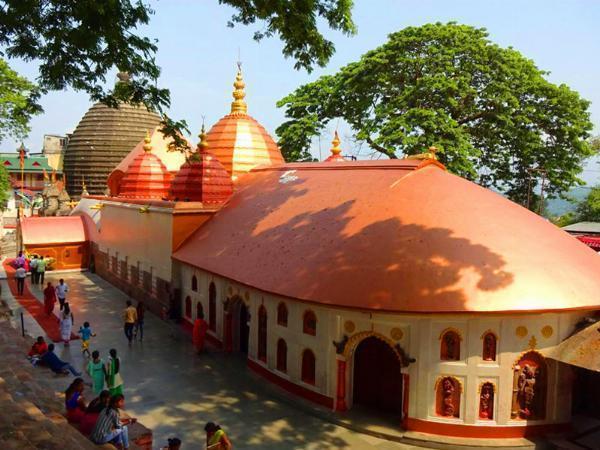The Mystique of Maa Kamakhya Temple: A Sacred Abode of Shakti

Strong 8k brings an ultra-HD IPTV experience to your living room and your pocket.
Visiting the picturesque hills of Assam, the Maa Kamakhya Temple stands as a revered site for millions of devotees, symbolizing the profound spiritual heritage of India. Known for its rich history, unique architecture, and deep-rooted cultural significance, this temple is dedicated to Goddess Kamakhya, an incarnation of the Divine Mother, or Shakti. This article delves into the history, significance, and unique rituals associated with the Maa Kamakhya Temple, illuminating its importance in the spiritual landscape of India.
Historical Background
The history of the Maa Kamakhya Temple is steeped in mythology and legend. It is believed to have been established in the 8th century CE, although some accounts suggest that its origins may date back even further. The temple is dedicated to the Goddess Kamakhya, who is considered to embody the feminine principle of the universe.
According to Hindu mythology, the temple is associated with the legend of Sati and Shiva. Sati, the daughter of King Daksha, was married to Lord Shiva. When King Daksha organized a grand yajna (sacrificial ritual) and failed to invite Shiva, Sati felt insulted and went to attend the ceremony alone. Faced with her father's disdain, Sati self-immolated. Heartbroken, Shiva roamed the universe with her lifeless body and in his grief, the cosmos began to tremble.
To restore balance, Lord Vishnu cut Sati's body into 51 pieces, which fell across various locations in India. It is believed that her yoni (female genitalia) fell at the site of the Maa Kamakhya Temple, marking it as a sacred spot for Shakti worship. This connection to the goddess's physical form imbues the temple with a unique spiritual significance.
Architectural Marvel
The Maa Kamakhya Temple is an architectural marvel, showcasing the rich artistic heritage of the region. Constructed in the Nagara style of architecture, the temple features a distinctive beehive-shaped dome called the Shikhara. The walls are adorned with intricate carvings and sculptures that depict various deities, making it a feast for the eyes.
The temple complex is constructed from stone and is surrounded by lush greenery, creating a serene environment that enhances its spiritual aura. The central shrine houses the Garbhagriha, which contains the sacred yoni stone, representing the goddess. Devotees come to offer their prayers and seek blessings from Maa Kamakhya, believing that she fulfills their wishes and protects them from negativity.
Religious Significance
The Maa Kamakhya Temple holds immense religious significance for followers of Shakti and Tantric traditions. It is considered one of the Shakti Peethas, a network of temples dedicated to the goddess, where her physical form is believed to reside. Devotees visit the temple to seek spiritual empowerment, healing, and prosperity.
One of the unique aspects of the temple is its association with Tantric practices. Tantrism emphasizes the worship of the divine feminine and often involves rituals that are considered unconventional in mainstream Hinduism. Many devotees believe that Maa Kamakhya has the power to grant wisdom, fertility and spiritual enlightenment.
The Ambubachi Mela
One of the most significant festivals celebrated at the Maa Kamakhya Temple is the Ambubachi Mela, which occurs annually in June. This festival marks the goddess's menstrual cycle and is a time of purification and renewal. During Ambubachi, the temple remains closed for three days, and devotees engage in various rituals and prayers to honor the goddess.
On the fourth day, the temple is reopened with much fanfare, and thousands of devotees flock to the temple to participate in the festivities. The Mela features various cultural programs, including music, dance, and traditional performances, reflecting the rich cultural heritage of Assam.
Unique Rituals and Practices
The rituals at Maa Kamakhya Temple are unique and deeply spiritual. Unlike many other temples where idols of deities are worshipped, the central focus here is on the yoni stone, representing the goddess's feminine energy. This signifies the importance of the goddess as the source of life and creation.
Devotees perform various offerings, including flowers, fruits, and red cloth, which are considered auspicious. The temple priests conduct elaborate rituals, invoking the goddess's blessings and ensuring that devotees receive spiritual guidance.
Another distinctive practice is the animal sacrifice that takes place during specific festivals. While this practice may be controversial, it is rooted in the belief that such offerings appease the goddess and ensure her blessings for prosperity and abundance.
Cultural Impact
The Maa Kamakhya Temple is not just a religious site; it is also a cultural hub that showcases the traditions and customs of the Assamese people. The temple attracts visitors from all over the country and abroad, making it a melting pot of cultures and beliefs.
Local artisans and craftsmen often display their works near the temple, offering visitors a glimpse into the rich artistic traditions of Assam. The fusion of spirituality and art creates a vibrant atmosphere that is unique to this sacred space.
Visiting the Temple
For those wishing to visit the Maa Kamakhya Temple, the best time is during the Ambubachi Mela when the temple comes alive with celebrations. However, the temple is open year-round, allowing devotees and tourists to experience its spiritual ambiance.
The temple is located on the Nilachal Hill, providing breathtaking views of the surrounding landscape. Visitors are encouraged to dress modestly and respect the sanctity of the site. It is advisable to plan your visit early in the day to avoid crowds and fully immerse yourself in the spiritual experience.
Conclusion
The Maa Kamakhya Temple is a symbol of divine feminine energy and a testament to the rich cultural heritage of India. Its unique rituals, deep-rooted history, and architectural beauty make it a must-visit destination for anyone interested in spirituality, history and culture.
Whether you are a devout follower seeking blessings or a curious traveler looking to explore the intricacies of Indian spirituality, the Maa Kamakhya Temple offers a unique experience that resonates deeply with the soul. As you stand before the sacred yoni stone, surrounded by the lush hills of Assam, you cannot help but feel the profound energy that this revered temple emanates.
Note: IndiBlogHub features both user-submitted and editorial content. We do not verify third-party contributions. Read our Disclaimer and Privacy Policyfor details.


